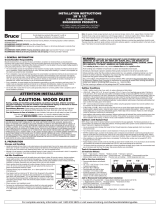
Woodworking Tips
SAWING
As they say, measure twice, cut once.
For the cleanest cut, consider these tips:
• Use a new, fine-tooth, 80-tooth or more, carbide,
combination sawblade.
• Score your cutline first using a straight edge and
a sharp blade, like a utility knife or razor blade.
(The cutline is the line the sawblade will travel.)
When measuring, add the width of the sawblade
to your mark.
• Give extra support to the wood fibers along
the cutline by running a piece of painters’ tape
over it.
• If an extra-clean cut is important, securely
clamp a second, thin piece of scrap wood to
the bottom of the piece you’re cutting.
• Frayed edges can be easily cleaned up with
some quick sanding. A badly chewed edge can
be repaired with wood filler or woody putty
as needed.
SANDING
• A smooth, ready-to-finish surface is accomplished
using a series of increasingly finer grit sand-
papers. Start with medium-fine grit like #120,
progress to #150, and end with #180. Note that
skipping a grit can leave scratches too deep for
the next grit to remove.
• Sand evenly and in the direction of the grain.
• Don’t oversand – you could potentially seal
the wood so tightly it won’t absorb finish.
• Be careful if using an electric sander (palm
or orbital) on veneer faces. They’re easy to
accidentally sand through with too much power.
• Wipe wood with a damp cloth to remove dust
after sanding.
• Don’t sand wood fiber panels (MDF, particleboard,
hardboard). These wood products already have
smooth surfaces, but when sanded, they also
create a tremendous amount of very fine saw-
dust that can irritate eyes and lungs.










